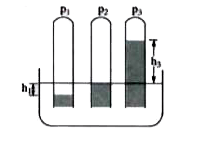For one mole of an ideal gas, if P = P01+(VV0)2 , where P0 and V0 are constants. Which of the following are true?Solution in Telugu
P=P0/2when V=V0
V=2V0 when P=P0
T=P0V0/2R when V=V0
R=PTV0 when P=P0
The correct Answer is:A, C
P=P01+(VV0)2
a) V=V0⇒P=P02
b) P=P0⇒1+(VV0)2=1⇒VV0=0.
c) V=V0⇒P=P02T=PVnR=P∘×V02R.
Topper's Solved these Questions
- BOOK - AAKASH SERIESCHAPTER - STATES OF MATTEREXERCISE - PRACTICE SHEET (EXERCISE -I) (LEVEL -II ADVANCED)(LINKED COMPREHENSION TYPE QUESTIONS)3videos
STATES OF MATTER
- BOOK - AAKASH SERIESCHAPTER - STATES OF MATTEREXERCISE - PRACTICE SHEET (EXERCISE -I) (LEVEL -II ADVANCED)(MATRIX MATCHING TYPE QUESTIONS)1videos
STATES OF MATTER
- BOOK - AAKASH SERIESCHAPTER - STATES OF MATTEREXERCISE - PRACTICE SHEET (EXERCISE -I) (LEVEL -II ADVANCED)(STRAIGHT OBJECTIVE TYPE QUESTIONS)9videos
STATES OF MATTER
- BOOK - AAKASH SERIESCHAPTER - SATURATED HYDROCARBONSEXERCISE - QUESTIONS FOR DESCRIPTIVE ANSWERS10videos
SATURATED HYDROCARBONS
- BOOK - AAKASH SERIESCHAPTER - STOICHIOMETRYEXERCISE - QUESTIONS FOR DESCRIPTIVE ANSWERS59videos
STOICHIOMETRY
Similar Questions
Consider gases confined by a liquid, as shown below. Density of the liquid = d.gmL−1h1andh3 in mm and p1,p2andp3 in mm Hg.

Barometric pressure is equal to02:22View SolutionColumn- Column-II A) Boyle's law P)Pobs=Patm+Pwater vapourB) Avagadro's law Q)V1=n1(V2n2)C) Charles' law R)Vt=V0(1+t273)D) Dalton's law S)V1=P2(V2P1)
04:28View SolutionThe molecular weights of two ideal gases A and B are respectively 100 and 200. One gram of A occupies V litres of volume at STP. What is the volume (in litres) occupied by one gram of B at STP ?
02:49View SolutionWhy boiling and melting points of hydrocarbons are low ?
01:29View SolutionDistinguish between element and compound?
03:48View SolutionOne mole of an ideal gas undergoes a process
p=p01+(VV0)2
where p0and V0 are constants. Find temperature of the gaas when V=V0.01:27View SolutionPressure of an ideal gas is given by P=P_(0)=[1-(1)/(2)((V_(0))/(V))^(2)]
02:31View SolutionPressure of 1 mole ideal is given by P=P_(0)[1-(1)/(2)(V_(0)/(V))^(2)]
03:57View SolutionOne mole of a diatomic gas undergoes a process P=P0/[1+(V/V30)] where P0 and V0 are constant. The translational kinetic energy of the gas when V=V0 is given by
03:41View SolutionOne mole of an ideal gas undergoes a process P=P0[1+(2V0V)2]−1, where P0V0 are constants. Change in temperature of the gas when volume is changed from V=V0→V=2V0 is:
03:33View SolutionFor one mole of ideal gas if P=(P_(0))/(1+((V)/(V_(0)))) where P_(0) and V_(0) are constant, then temperature of gas when V=V_(0) is:
04:30View SolutionOne mole of an ideal gas undergoes a process p=(p_(0))/(1+((V_(0))/(V))^(2)) . Here, p_(0) and V_(0) are constants. Change in temperature of the gas when volume is changed from V=V_(0) to V=2V_(0) is
01:34View Solutionएक आदर्श गैस का एक मोल ऐसे प्रक्रम से गुजरता है, जिसमे दाब तथा आयतन सूत्र p=p0[1−12(V0V)2] से सम्बंधित है। यहाँ, p0 तथा V0 नियतांक है। यदि गैस का आयतन V0 से बढ़कर 2V0 होता है, तो इसके तापमान का बदलाव होगा
01:56View SolutionFor one mole of an ideal gas, if P = P01+(VV0)2 , where P0 and V0 are constants. Which of the following are true?
02:40View SolutionOne mole of an ideal gas undergoes a process
p=p01+(VV0)2
where p0and V0 are constants. Find temperature of the gaas when V=V0.View SolutionPressure of 1 mole ideal is given by
P=P0[1−12(V0V)2] V0 to 2V0. Find change in temperature.View Solution

